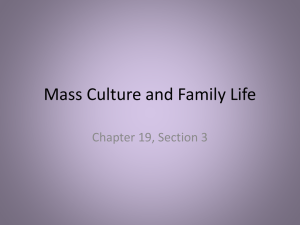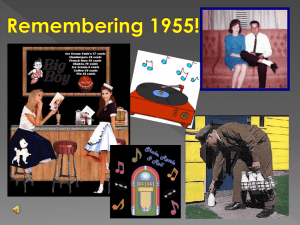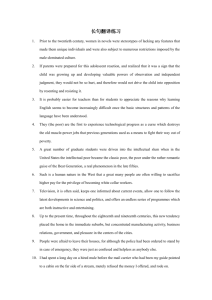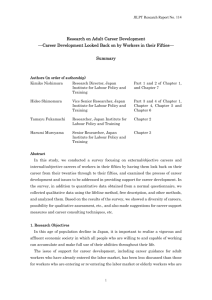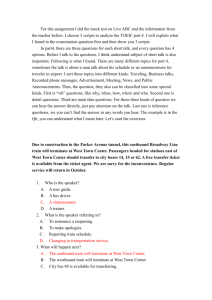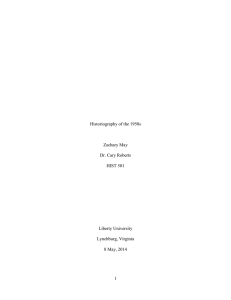Boomers and Bomb Shelters
advertisement
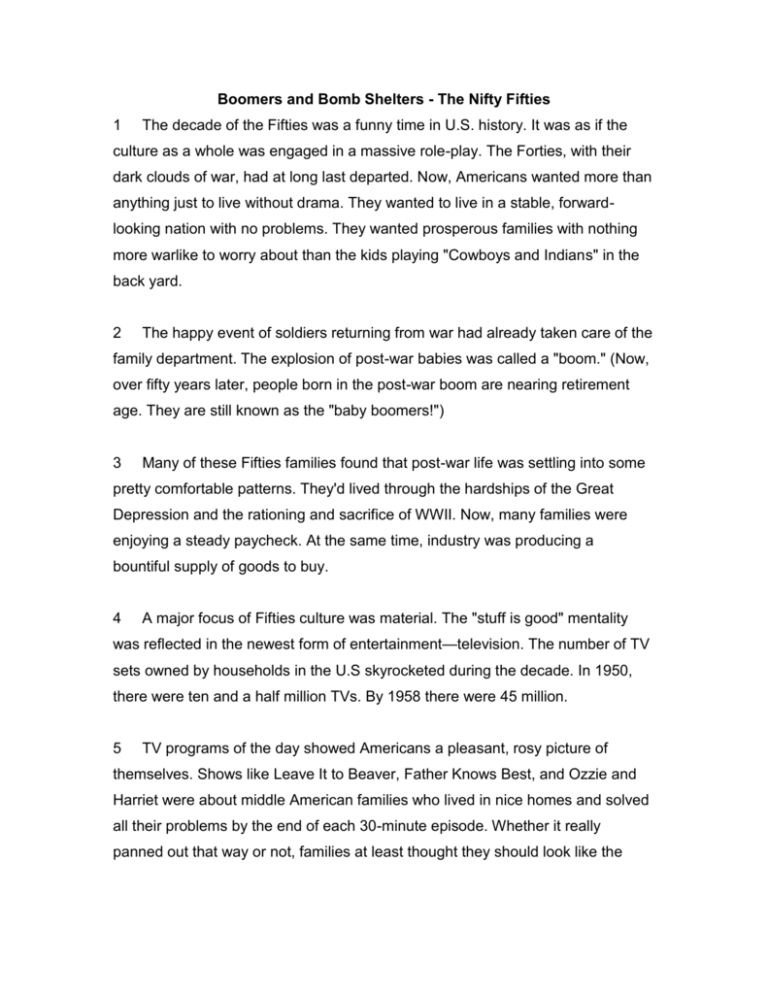
Boomers and Bomb Shelters - The Nifty Fifties 1 The decade of the Fifties was a funny time in U.S. history. It was as if the culture as a whole was engaged in a massive role-play. The Forties, with their dark clouds of war, had at long last departed. Now, Americans wanted more than anything just to live without drama. They wanted to live in a stable, forwardlooking nation with no problems. They wanted prosperous families with nothing more warlike to worry about than the kids playing "Cowboys and Indians" in the back yard. 2 The happy event of soldiers returning from war had already taken care of the family department. The explosion of post-war babies was called a "boom." (Now, over fifty years later, people born in the post-war boom are nearing retirement age. They are still known as the "baby boomers!") 3 Many of these Fifties families found that post-war life was settling into some pretty comfortable patterns. They'd lived through the hardships of the Great Depression and the rationing and sacrifice of WWII. Now, many families were enjoying a steady paycheck. At the same time, industry was producing a bountiful supply of goods to buy. 4 A major focus of Fifties culture was material. The "stuff is good" mentality was reflected in the newest form of entertainment—television. The number of TV sets owned by households in the U.S skyrocketed during the decade. In 1950, there were ten and a half million TVs. By 1958 there were 45 million. 5 TV programs of the day showed Americans a pleasant, rosy picture of themselves. Shows like Leave It to Beaver, Father Knows Best, and Ozzie and Harriet were about middle American families who lived in nice homes and solved all their problems by the end of each 30-minute episode. Whether it really panned out that way or not, families at least thought they should look like the ones on TV, with Dad going off to work and Mom in the housewife role. The male-female employment rate was 5-1 at the time. 6 Homes—preferably located outside the busy, smoggy cities—were an important purchase for Fifties families. The decade saw a mass migration of city dwellers to a new Utopia—the suburbs. There were some nagging problems in Paradise, however. While many white families acquired mortgages and bought homes in Suburbia, families of other races weren't so fortunate. A higher percentage of mortgage requests from black and Hispanic families were denied by banks. They ran into trouble in the course of pursuing the American Dream of home ownership. 7 Federal funds had been set aside to make it easier for low-income families to own homes. Non-white applicants were approved for these loans more frequently than they were for regular bank loans. But there were often only certain areas of a city in which a non-white family could purchase a home with the loaned funds. The dreams non-whites had of moving their families out of crowded ghettos often went unfulfilled. 8 Investigators discovered that banks and some government housing officials had actually taken maps of their cities and marked off certain areas, sometimes with red pencil. These were usually poor, non-white neighborhoods. No money would be loaned for purchases within the marked areas. This practice came to be called "redlining." Eventually, discrimination in lending was outlawed. In the Fifties, however, it intensified segregation and poverty in cities. 9 Many civic governments in the Fifties era took action to "clean up" the inner cities. The Federal Highway Department began building roadways through the heart of urban areas. Older, shabbier sectors were demolished to make space for new freeways and sparkling new cityscapes. This process of "urban renewal" displaced thousands of residents. Many were turned out of what had been thriving—if somewhat down at the heels—ethnic neighborhoods. 10 Relations between blacks and whites was a problem simmering below the surface of the Fifties culture. The struggle for civil rights was not new. In the Fifties, however, America saw the first effective stirrings of the Civil Rights Movement that would ultimately change the nation. It began with individual black people refusing to bow to segregation in schools and buses. Leaders like Dr. Martin Luther King, Jr. arose during the Fifties to give focus and structure to civil rights efforts. 11 For the most part, rural and small-town America lived the idyllic Fifties image. They didn't have to worry about urban renewal or race riots. There was another problem lurking in the depths of the nation's consciousness, however— one that touched farm and city dweller alike. A potent fear had invaded the country. Communism and the atomic bomb had become the stuff of which nightmares are made. 12 People feared China and/or Russia would launch a nuclear attack against the U.S. Many families built some type of shelter in their backyards. They hoped the bunkers would protect them in case of a nuclear explosion. In addition to nuclear worries, a major panic took place in the U.S. over the elusive "enemy within." Were Communist sympathizers in the U.S. on a covert mission to undermine the system? Suspected Communists were blacklisted and harassed. As weary of war as they were, Americans answered the trumpet call again as the UN battled Communism in Korea. 13 In the Fifties, America was caught between what it wanted to be and what it was. Like a child trying to look confident and dignified, dressed up in Mother's heels or Father's business suit, it kept tripping on the carpet. Directions: Please answer the following questions on a separate sheet of paper. 1. What factors brought about the cultural climate of the Fifties? 2. Judging from general trends of the era, what would you say people of the Fifties wanted their lives to be like? 3. How were the lives of non-white families different from whites in the Fifties? 4. Who are "Baby boomers? 5. What was one of the most popular consumer items in the Fifties? 6. What did television programming of the Fifties tend to portray? 7. How were "Redlining" and urban renewal related? 8. The article is written from the point of view that the Fifties was a time when American culture was trying to be something that it never quite achieved. Do you agree with this view? Why or why not? Give an example of how individuals and families are influenced by the times in which they live. Use at least two different generations of people to illustrate your example. Interview at least two people of the "baby boomer" generation. Ask them to describe the Fifties and Sixties, the era in which they grew up. Ask them to compare the cultural climate of today to that of their growing-up years. Write a paragraph or two summing up what you learn from them.
